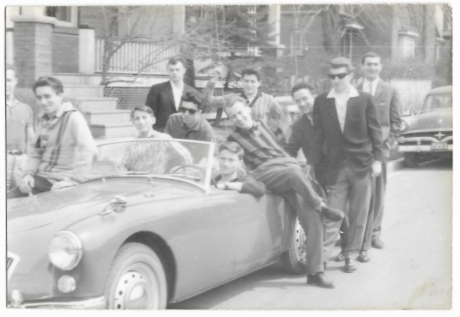Andy Réti recently contacted the OJA eager to share his Bathurst Manor story. Although Andy never lived in the Manor, he quickly realized that he has been connected to the neighbourhood throughout his Toronto life. Andy’s story begins with his reminiscences of the first party he attended in the Manor in 1960, shortly after his arrival to Toronto from Hungary, confessing “we were all car- and girl-crazy—but not necessarily in that order”, to his present-day volunteer work as a Holocaust survivor speaker at the Neuberger Holocaust Education Centre.
By Andy Réti
I was invited to a house party in the Overbrook and Wilmington area. The year was 1960, and I didn’tknow that I needed two tokens to get there. The bus stopped at Eglinton and Bathurst, and I had to pay a second token before the driver moved on. I didn’t know that my destination was in a new development called the Manor.
I was such a “greener,” and there were so many other things I didn’t know yet, including the fact that we Jews tend to migrate a lot. The time I am reminiscing about is 1958–1960—just after my mother and I arrived in Toronto. The Manor was only the first of many new destinations for Toronto’s Jewish community. Years later when I was a father of two young children, I too moved to another new suburb at Leslie and Greenlane.
In 1960, I also didn’t know that three institutions located in the Manor—the Bathurst Jewish Community Centre (formerly YMHA or Y), B’nai Brith, and the Holocaust Centre—would become an integral, almost central, part of my life. My connections to the Y at Spadina and Bloor started in 1958, where my fellow Hungarians and I met the young ladies who already lived in the Manor or were in the process of moving there. I started my thirty-year volunteer swimming instructor and lifeguarding career at the Y and continued at the BJCC. Years later, I became a survivor speaker at the Holocaust Centre located in the Lipa Green building, right next to the BJCC.
The street was Pannahill, and the home had a recreation room in the basement with a wet bar. I had no idea that homes had anything other than an apartment in their basement. Everything was new and exciting: the house, the furniture, the people, the food, the music, the dresses, and, of course, the cars on the driveways and in the streets. We were all car- and girl-crazy—but not necessarily in that order.
Over the years, the friendships and relations changed but the memories are still vivid; it was my first impression of suburbia. Julius, my classmate from Hungary, was the first from our group to get married. He married Drora, a Manor girl. I was the best man at their wedding. That wedding was the beginning for all of us on our way to become adults and to have our own families.
Although I never lived in the Manor, I spent a lot of time there. Until I saw the invitation to contribute to the OJA’s project to collect the history of Jewish life in the Manor, I didn’t consider how much of my life I spent there. It was not the geographical location that mattered or made a difference; it was the people and what we did.
I became a volunteer and eventually a Holocaust survivor speaker after my dear mother passed away in 2005. This is my twenty-second year as a Holocaust educator. I speak to hundreds of people annually. In each presentation, I make it a point to announce that I live in the Bathurst and Sheppard area, which is still a predominantly Jewish neighbourhood.
Since I live on Alexis Boulevard, the first street south of Sheppard, I firmly believe that this makes me an honorary Manorite.
 Andy at 78; Husband, Father, Grandfather, Survivor Speaker, Writer, Author, Motorcycle rider, and taxi industry veteran. He tells his kids that he has a Phd. in life skills but they don’t listen.
Andy at 78; Husband, Father, Grandfather, Survivor Speaker, Writer, Author, Motorcycle rider, and taxi industry veteran. He tells his kids that he has a Phd. in life skills but they don’t listen.


